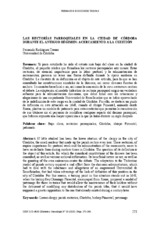Las rectorías parroquiales en la ciudad de Córdoba durante el Antiguo Régimen: acercamiento a la cuestión
Autor
Rodríguez-Trenas, Fernando
Editor
Universidad de Córdoba, UCOPressFecha
2020Materia
Bajo cleroRectorías parroquiales
Córdoba (España)
Obispo Pimentel
Patronato
Lower clergy
Parish rectories
Bishop Pimentel
Patronage
METS:
Mostrar el registro METSPREMIS:
Mostrar el registro PREMISMetadatos
Mostrar el registro completo del ítemResumen
Si
poco
estudiado
ha
sido
el
estrato
más
bajo
del
clero
en
la
ciudad
de
Córdoba,
el
pequeño
núcleo
que
formaban
los
rectores
parroquiales
aún
menos.
Estas
rectorías,
de
esencial
importancia
para
la
labor
pastoral
y
la
administración
de
sacramentos,
parecen
no
tener
una
forma
definida
durante
la
época
moderna
en
Córdoba.
La
cuestión
de
su
definición
es
el
objeto
de
este
artículo,
para
lo
que
se
han
consultado
las
constituciones
sinodales
de
la
diócesis,
así
como
diversa
s
fuentes
de
archivo.
Su
carácter
benef
icial
o
no,
así
como
la
concesión
de
la
cura
animarum
centran
el
debate.
La
adaptación
al
modelo
tridentino
de
rectoría
parroquial
exigió
un
verdadero
esfuerzo
para
la
administración
diocesana,
que
debió
lidiar
con
las
reticencias
y
alegaciones
de
una
empo
derada
Universidad
de
Beneficiados
que
se
había
aprovechado
de
la
indefinición
de
este
cargo
en
la
ciudad
de
Córdoba.
Por
ello,
se
destaca
un
punto
de
inflexión
en
esta
situación
en
1648,
cuando
el
obispo
Pimentel,
animado
desde
Roma,
plantea
un
modelo
de
patronato
para
estas
rectorías
que
permitan
la
manutención
de
sus
titulares
sin
el
perjuicio
de
modificar
cualquier
reparto
del
diezmo
parroquial,
que
hubiera
supuesto
una
mayor
oposición
a
la
que
ya
hubo
durante
un
siglo
después. If
little
studied
has
been
the
lower
stratum
of
the
clergy
in
the
city
of
C
ó
rdoba,
the
small
nucleus
that
made
up
the
parish
rectors
even
less.
These
rectories,
of
supine
importan
ce
for
pastoral
work
and
the
administration
of
the
sacraments,
seem
to
have
no
definite
form
during
modern
times
in
C
ó
rdoba.
The
question
of
its
definition
is
the
object
of
this
article,
for
which
the
synodical
constitutions
of
the
diocese
has
been
consult
ed,
as
well
as
various
archival
information.
Its
beneficial
nature
or
not,
as
well
as
the
granting
of
the
cura
animarum
center
the
debate
.
T
he
adaptation
to
the
Tridentine
model
of
parish
rectory
required
a
real
effort
fr
om
the
diocesan
administration,
whi
ch
had
to
deal
with
the
reluctance
and
allegations
of
an
empowered
Universidad
de
Beneficiados,
that
had
taken
advantage
of
the
lack
of
definition
of
this
position
in
the
city
of
C
ó
rdoba.
For
this
reason,
a
turning
point
in
this
situation
stands
out
in
164
8,
when
the
bishop
fray
Domingo
Pimentel,
encouraged
from
Rome,
proposed
a
model
of
patronage
for
these
rectories
that
would
allow
the
maintenance
of
their
holders
without
the
detriment
of
modifying
any
distribution
of
the
parish
tithe,
that
it
would
have
supposed
a
greater
opposition
to
the
one
that
already
existed
during
a
century
later.

